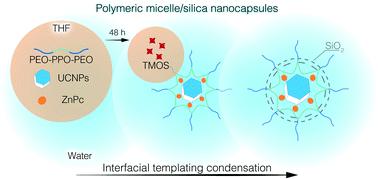当前位置:
X-MOL 学术
›
Chem. Sci.
›
论文详情
Our official English website, www.x-mol.net, welcomes your feedback! (Note: you will need to create a separate account there.)
One-pot synthesis of theranostic nanocapsules with lanthanide doped nanoparticles
Chemical Science ( IF 8.4 ) Pub Date : 2020-06-01 , DOI: 10.1039/d0sc01033b Miao Wang 1, 2, 3, 4, 5 , Yu Zhang 6, 7, 8 , Michael Ng 7, 8, 9 , Artiom Skripka 1, 2, 3, 4, 5 , Ting Cheng 1, 2, 3, 4, 5 , Xu Li 1, 2, 3, 4, 5 , Kishore Kumar Bhakoo 7, 8, 9 , Alex Y. Chang 10, 11, 12, 13, 14 , Federico Rosei 1, 2, 3, 4, 5 , Fiorenzo Vetrone 1, 2, 3, 4, 5
Chemical Science ( IF 8.4 ) Pub Date : 2020-06-01 , DOI: 10.1039/d0sc01033b Miao Wang 1, 2, 3, 4, 5 , Yu Zhang 6, 7, 8 , Michael Ng 7, 8, 9 , Artiom Skripka 1, 2, 3, 4, 5 , Ting Cheng 1, 2, 3, 4, 5 , Xu Li 1, 2, 3, 4, 5 , Kishore Kumar Bhakoo 7, 8, 9 , Alex Y. Chang 10, 11, 12, 13, 14 , Federico Rosei 1, 2, 3, 4, 5 , Fiorenzo Vetrone 1, 2, 3, 4, 5
Affiliation

|
We report a one-pot synthesis strategy for a new theranostic nanoplatform by simultaneously encapsulating Er3+, Yb3+ doped NaGdF4 upconverting nanoparticles (UCNPs) and photosensitizer zinc phthalocyanine (ZnPc) into polymeric micelle/silica nanocapsules. This approach consists of interfacial templating condensation, using triblock copolymers, namely (ethylene oxide)106(propylene oxide)70(ethylene oxide)106 (PEO-PPO-PEO) as the templating and protecting agent. The encapsulation follows a straightforward microemulsion mechanism in an aqueous environment at a near-neutral pH. To prevent the interaction between the hydrophobic oleic acid (OA) ligands of UCNPs and the silanol groups of hydrated tetramethoxysilane (TMOS), we adjusted the addition sequence of TMOS. It allowed us first to encapsulate UCNPs in PEO-PPO-PEO micelles, and then grow the silica shell within the micellar PPO core and PEO corona interface. The silica shell is incorporated for its chemical and mechanical stability, while the PEO corona gives additional steric balance to the nanocapsule. Using this strategy we successfully co-encapsulated UCNPs and ZnPc in one-pot, and minimized the distance between the two payloads to facilitate the energy transfer from UCNPs to ZnPc. The integrated nanocapsule has an average hydrodynamic size of 85 nm with a low polydispersity index of 0.1, and demonstrates excellent colloidal stability, biocompatibility, enhanced negative contrast for T2-weighted imaging and photodynamic therapy. The latter is obtained through indirect excitation of co-encapsulated ZnPc by UCNPs, resulting in singlet oxygen generation and in vitro eradication of BT474 breast cancer cells. Overall, the presented one-pot approach shines light on the co-encapsulation of OA-capped inorganic UCNPs with hydrophobic photosensitizers, constituting an important step forward in the surface engineering of UCNPs, as well as upconversion based photodynamic therapy systems.
中文翻译:

镧系元素掺杂纳米粒子一锅法合成治疗型纳米胶囊
我们报告了通过同时封装Er 3+,Yb 3+掺杂的NaGdF 4上转换纳米颗粒(UCNPs)和光敏剂锌酞菁(ZnPc)到聚合物胶束/二氧化硅纳米胶囊的一锅法合成新疗法纳米平台。该方法包括使用三嵌段共聚物(即(环氧乙烷)106(环氧丙烷)70(环氧乙烷)106)的界面模板缩合(PEO-PPO-PEO)作为模板和保护剂。在接近中性pH的水性环境中,封装遵循直接的微乳液机理。为了防止UCNPs的疏水油酸(OA)配体与水合四甲氧基硅烷(TMOS)的硅烷醇基团相互作用,我们调整了TMOS的添加顺序。它允许我们首先将UCNPs封装在PEO-PPO-PEO胶束中,然后在胶束PPO核和PEO电晕界面内生长二氧化硅壳。由于其化学和机械稳定性而结合了二氧化硅壳,而PEO电晕为纳米胶囊提供了额外的空间平衡。使用此策略,我们成功地将UCNP和ZnPc共封装在一个罐中,并最小化了两个有效载荷之间的距离,以促进从UCNP到ZnPc的能量转移。T 2加权成像和光动力疗法。后者是通过UCNPs间接激发共包封的ZnPc,从而产生单线态氧并体外消除BT474乳腺癌细胞而获得的。总体而言,提出的一锅法为OA封端的无机UCNP与疏水性光敏剂的共包封提供了亮点,这是UCNPs表面工程以及基于上转换的光动力治疗系统向前迈出的重要一步。
更新日期:2020-07-08
中文翻译:

镧系元素掺杂纳米粒子一锅法合成治疗型纳米胶囊
我们报告了通过同时封装Er 3+,Yb 3+掺杂的NaGdF 4上转换纳米颗粒(UCNPs)和光敏剂锌酞菁(ZnPc)到聚合物胶束/二氧化硅纳米胶囊的一锅法合成新疗法纳米平台。该方法包括使用三嵌段共聚物(即(环氧乙烷)106(环氧丙烷)70(环氧乙烷)106)的界面模板缩合(PEO-PPO-PEO)作为模板和保护剂。在接近中性pH的水性环境中,封装遵循直接的微乳液机理。为了防止UCNPs的疏水油酸(OA)配体与水合四甲氧基硅烷(TMOS)的硅烷醇基团相互作用,我们调整了TMOS的添加顺序。它允许我们首先将UCNPs封装在PEO-PPO-PEO胶束中,然后在胶束PPO核和PEO电晕界面内生长二氧化硅壳。由于其化学和机械稳定性而结合了二氧化硅壳,而PEO电晕为纳米胶囊提供了额外的空间平衡。使用此策略,我们成功地将UCNP和ZnPc共封装在一个罐中,并最小化了两个有效载荷之间的距离,以促进从UCNP到ZnPc的能量转移。T 2加权成像和光动力疗法。后者是通过UCNPs间接激发共包封的ZnPc,从而产生单线态氧并体外消除BT474乳腺癌细胞而获得的。总体而言,提出的一锅法为OA封端的无机UCNP与疏水性光敏剂的共包封提供了亮点,这是UCNPs表面工程以及基于上转换的光动力治疗系统向前迈出的重要一步。



























 京公网安备 11010802027423号
京公网安备 11010802027423号